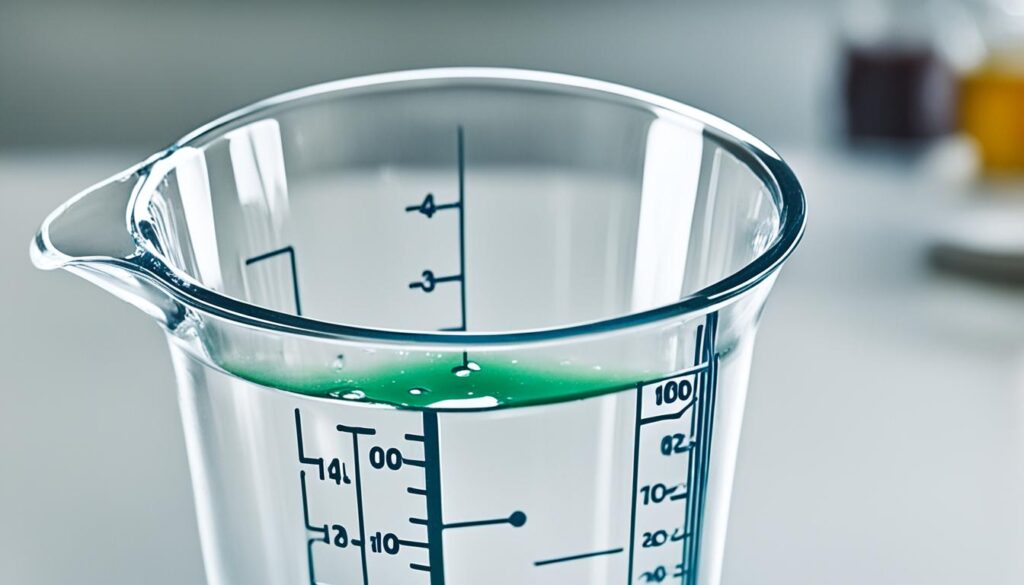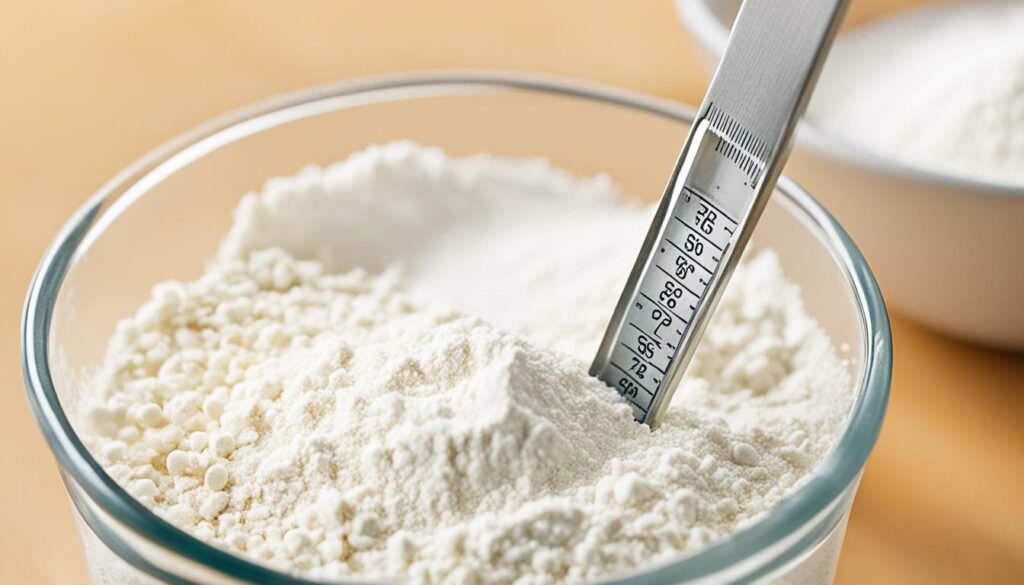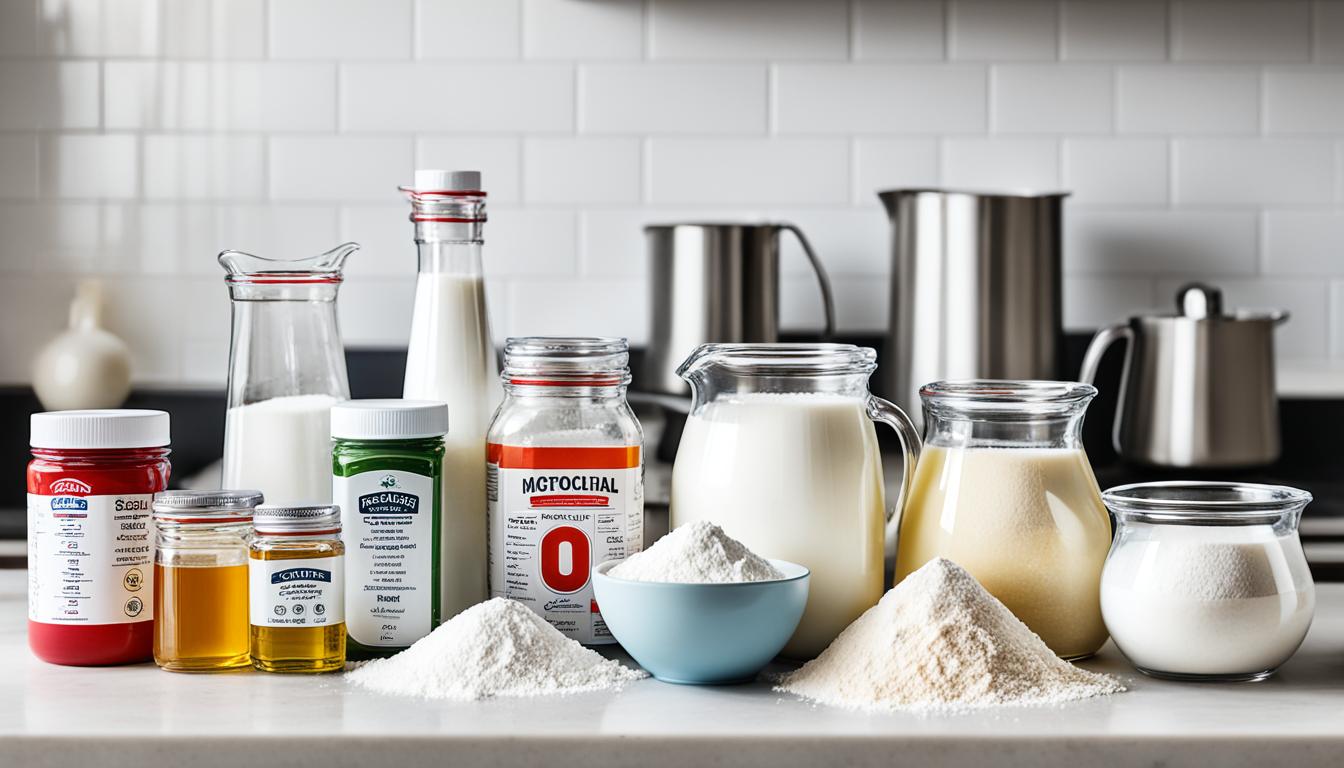Have you ever wondered why some bakers consistently achieve perfect results with their recipes, while others struggle to get it right? The secret lies in the art of accurate measuring. Baking is a science that requires precise measurements of both wet and dry ingredients for optimal taste, texture, and consistency. But how can you ensure that you’re measuring ingredients accurately?
- Using the right tools for measuring
- Understanding the difference between volume and weight measurements
- Best practices for measuring wet and dry ingredients
- Tips for measuring dry ingredients accurately
- The importance of weighing ingredients
Now, let’s dive deeper into the world of accurate baking measurements and discover the best methods for measuring wet and dry ingredients. Understanding these fundamental techniques will elevate your baking skills and ensure consistent and delicious results every time.
Key Takeaways:
- Accurate measuring is crucial for successful baking.
- Using the right tools and techniques is essential for measuring wet and dry ingredients.
- Understanding volume and weight measurements is crucial for precision.
- Accurate measuring of wet ingredients requires proper liquid measuring cups.
- Measuring dry ingredients accurately involves the dip and sweep method.
- Weighing ingredients provides greater precision and consistency in baking.
Measuring Wet and Dry Ingredients for Baking
When it comes to baking, precise measurement of ingredients is key to achieving the best results. Using accurate baking ingredient measurement techniques and following best practices for measuring baking ingredients ensures that your baked goods turn out perfectly every time. In this section, we will explore the proper techniques for measuring both wet and dry ingredients, providing you with the necessary knowledge to enhance your baking precision.
Measuring Wet Ingredients
Wet ingredients such as milk, water, and oils require special attention when measuring. To accurately measure wet ingredients, it is important to use liquid measuring cups. These cups are specifically designed to measure liquids and are typically made of glass or clear plastic, allowing for easy reading of measurements.
When measuring wet ingredients:
- Place the liquid measuring cup on a flat surface to ensure accurate measurements.
- Pour the liquid into the cup, stopping just below the desired measurement line.
- Take note of the meniscus, the curved surface of the liquid that forms in the cup, and adjust the measurement accordingly.
For smaller quantities of wet ingredients, using measuring spoons can be more practical.
Measuring Dry Ingredients
Accurately measuring dry ingredients like flour, sugar, and cocoa powder is crucial for achieving the desired texture and taste in your baked goods. When measuring dry ingredients, it is recommended to use dry measuring cups or spoons.
To measure dry ingredients:
- Using a dry measuring cup, scoop the ingredient into the cup.
- Level off the excess using the back of a straight edge, such as a knife or spatula, to ensure a precise measurement.
It is essential to avoid packing down the ingredient or tapping the cup, as this can lead to inaccurate measurements. If a recipe calls for sifted dry ingredients, be sure to sift the ingredient before measuring for consistent and precise results.
Now that we have covered the basics of measuring wet and dry ingredients, it’s time to explore the importance of understanding volume and weight measurements. Understanding the difference between these two measurement methods will further enhance your baking precision and allow you to confidently create delicious treats.
Understanding Volume and Weight Measurements
Volume measurements, such as cups and tablespoons, are commonly used in baking recipes. It’s important to note that a cup is not the same as a coffee cup or a teacup. The standard cup measurement in the United States is approximately 240 milliliters, while in other parts of the world, it may be 284 milliliters. Understanding the difference between volume and weight measurements is crucial for precise baking.
Volume Measurements
When using volume measurements, it’s important to use the correct measuring cups and spoons. Liquid measuring cups should be used for liquid ingredients like water, milk, and oils, while dry measuring cups and spoons should be used for dry ingredients like flour and sugar.
“The standard cup measurement in the United States is approximately 240 milliliters, while in other parts of the world, it may be 284 milliliters.”
It’s also important to ensure that you are using level measurements when using volume measurements. For dry ingredients, use a straight edge, like a knife or spatula, to level off the excess ingredient. For liquids, make sure the liquid reaches the correct measurement line on the measuring cup.
Weight Measurements
Weight measurements can provide more accurate results in baking. Using a kitchen scale allows you to measure ingredients by weight rather than volume. This method eliminates any inconsistencies that can occur with volume measurements.
When using weight measurements, it’s important to ensure that you are using the correct unit of measurement, such as grams or ounces. Refer to your recipe for the specified unit of measurement and use the kitchen scale to measure the precise amount of each ingredient.
| Ingredient | Volume Measurement | Weight Measurement (grams) |
|---|---|---|
| All-Purpose Flour | 1 cup | 120g |
| Sugar | 1 cup | 200g |
| Butter | 1/2 cup | 113g |
| Milk | 1 cup | 240g |
By understanding the difference between volume and weight measurements and using the appropriate tools and techniques, you can ensure more precise baking measurements. Whether you choose to use volume measurements or weight measurements, consistency and attention to detail are key.
Best Practices for Measuring Wet Ingredients
When it comes to baking, accurate measuring of wet ingredients is essential for achieving the perfect consistency and flavor in your baked goods. To ensure precise measurements, it’s important to use the right tools and techniques.
One of the key tools you’ll need is accurate liquid measuring cups. These cups are specifically designed with a pour spout to make it easier to measure liquids. They come in various sizes to accommodate different quantities of wet ingredients.
To measure liquids correctly, start by placing the liquid measuring cup on a flat surface. Pour the liquid slowly into the cup until it reaches just below the desired line. It’s crucial to adjust for the meniscus, which is the curved surface of the liquid that forms in the cup. This ensures that you are measuring the exact amount needed.
For small quantities of wet ingredients, using dry measuring cups or spoons can be more practical. However, for larger quantities, it’s best to use liquid measuring cups to obtain accurate results. Remember to always refer to your recipe instructions for the specific measuring requirements of each liquid ingredient.

Properly measuring wet ingredients is especially important when it comes to critical elements like water, milk, and oils. Adding too much or too little of these liquids can significantly affect the texture and taste of your final product.
“Accurate measuring of wet ingredients is crucial for maintaining the right balance of flavors and ensuring the desired texture in your baked goods.” – Baking Expert
Tips for Measuring Wet Ingredients:
- Use accurate liquid measuring cups with pour spouts.
- Place the measuring cup on a flat surface for precise measurements.
- Pour the liquid slowly until it is just below the desired line.
- Adjust for the meniscus, the curved surface of the liquid in the cup.
- Refer to your recipe instructions for specific measuring requirements.
By following these best practices for measuring wet ingredients, you’ll be able to maintain the integrity of your recipes and achieve consistent baking results every time.
Tips for Measuring Dry Ingredients
When it comes to baking, accurate measurement of dry ingredients is key to achieving consistent and delicious results. Whether you’re measuring flour, sugar, or other dry ingredients, using the right techniques can make all the difference. Here are some tips to help you measure dry ingredients accurately:
- Dry Measuring Cups: Use dry measuring cups specifically designed for measuring dry ingredients. These cups are typically made of metal or plastic and come in various sizes. They provide a level surface for accurate measurement.
- The Dip and Sweep Method: This is a common technique used for measuring dry ingredients. To measure using this method, simply dip the dry measuring cup into the container of the ingredient, then use a straight edge to sweep off any excess. This ensures you have the correct amount without packing down the ingredient.
- Avoid Packing Down: It’s important to avoid packing down the dry ingredient when measuring. Packing it down can lead to a heavier measurement and throw off the balance of the recipe. Instead, lightly spoon the ingredient into the measuring cup and level off the top with a straight edge.
- Sifting Flour: Sifting flour before measuring can help ensure accurate results. It helps to remove any lumps and aerates the flour, making it easier to measure and mix into your batter or dough.
By following these tips, you can measure dry ingredients accurately and achieve precise results in your baking. Consistency in measurement translates to consistent results in your baked goods, so take the time to measure carefully.

Common Dry Ingredient Measurements
| Ingredient | Volume Measurement | Weight Measurement |
|---|---|---|
| All-Purpose Flour | 1 cup | 120 grams |
| Granulated Sugar | 1 cup | 200 grams |
| Brown Sugar (packed) | 1 cup | 220 grams |
| Baking Powder | 1 teaspoon | 4 grams |
| Baking Soda | 1/2 teaspoon | 2 grams |
The Importance of Weighing Ingredients
While volume measurements are commonly used in baking, weighing ingredients can provide more precise results. A kitchen scale is a valuable tool for accurately measuring ingredients by weight. It eliminates the inconsistencies that can occur with volume measurements and allows for greater precision. By weighing ingredients, you can ensure that you are using the exact amount required by the recipe, resulting in more consistent and successful bakes.
When you measure baking ingredients by weight, you are able to achieve a level of accuracy that is not possible with volume measurements alone. Weight measurements are not affected by factors such as the density or texture of the ingredient, ensuring consistent results every time.
Using a kitchen scale for baking offers several benefits:
- Accuracy: Measuring ingredients by weight ensures that your recipes turn out as intended, with the right balance of flavors and textures.
- Consistency: By weighing your ingredients, you can recreate your favorite recipes with consistent results, making it easier to share and replicate your baking successes.
- Flexibility: Weighing ingredients allows you to easily adjust the quantities based on the number of servings or portion sizes you require.
- Recipe Conversion: If you come across a recipe that uses different measurement units (such as cups or grams), a kitchen scale can easily help you convert the measurements accurately.
Whether you are a professional baker or a home cook who loves to bake, investing in a kitchen scale is worth considering. It will enable you to take your baking skills to the next level and achieve consistently delicious results.
| Ingredient | Volume Measurement | Weight Measurement |
|---|---|---|
| All-Purpose Flour | 1 cup | 120 grams |
| Granulated Sugar | 1 cup | 200 grams |
| Butter | 1 cup | 227 grams |
| Milk | 1 cup | 240 grams |
| Chocolate Chips | 1 cup | 170 grams |
Conclusion
Accurately measuring wet and dry ingredients is crucial for achieving the best results in baking. To ensure baking accuracy and achieve precise baking measurements, it’s important to use the right tools and techniques. By utilizing liquid and dry measuring cups, practicing the spoon and level method, and incorporating a kitchen scale into your baking routine, you can guarantee that your ingredients are measured accurately every time.
Consistency and attention to detail are key when it comes to achieving precise baking measurements. Whether you prefer volume measurements or weight measurements, the important thing is to establish a consistent approach and follow it diligently. Remember, precision in your measurements will ultimately result in more consistent and delicious baked treats.
By implementing these baking accuracy tips, you can elevate your baking skills and create mouthwatering treats with confidence. Whether you’re a novice baker or a seasoned pro, practicing accurate measurement techniques is essential for producing the best possible outcomes in your baked goods. So, grab your measuring cups, level that flour, and embrace the art of precise baking! Your taste buds will thank you for it.
